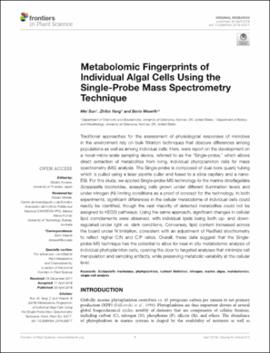| dc.contributor.author | Sun, Mei | |
| dc.contributor.author | Yang, Zhibo | |
| dc.contributor.author | Wawrik, Boris | |
| dc.date.accessioned | 2018-05-02T15:41:34Z | |
| dc.date.available | 2018-05-02T15:41:34Z | |
| dc.date.issued | 2018-04-30 | |
| dc.identifier.citation | Sun M, Yang Z and Wawrik B (2018) Metabolomic Fingerprints of Individual Algal Cells Using the Single-Probe Mass Spectrometry Technique. Front. Plant Sci. 9:571. doi: 10.3389/fpls.2018.00571 | en_US |
| dc.identifier.uri | https://hdl.handle.net/11244/299693 | |
| dc.description.abstract | Traditional approaches for the assessment of physiological responses of microbes in the environment rely on bulk filtration techniques that obscure differences among populations as well as among individual cells. Here, were report on the development on a novel micro-scale sampling device, referred to as the “Single-probe,” which allows direct extraction of metabolites from living, individual phytoplankton cells for mass spectrometry (MS) analysis. The Single-probe is composed of dual-bore quartz tubing which is pulled using a laser pipette puller and fused to a silica capillary and a nano-ESI. For this study, we applied Single-probe MS technology to the marine dinoflagellate Scrippsiella trochoidea, assaying cells grown under different illumination levels and under nitrogen (N) limiting conditions as a proof of concept for the technology. In both experiments, significant differences in the cellular metabolome of individual cells could readily be identified, though the vast majority of detected metabolites could not be assigned to KEGG pathways. Using the same approach, significant changes in cellular lipid complements were observed, with individual lipids being both up- and down-regulated under light vs. dark conditions. Conversely, lipid content increased across the board under N limitation, consistent with an adjustment of Redfield stoichiometry to reflect higher C:N and C:P ratios. Overall, these data suggest that the Single-probe MS technique has the potential to allow for near in situ metabolomic analysis of individual phytoplankton cells, opening the door to targeted analyses that minimize cell manipulation and sampling artifacts, while preserving metabolic variability at the cellular level. | en_US |
| dc.description.sponsorship | Support for this work came from United States National Science Foundation (Grant No. OCE-1634630) from the Biological Oceanography program and from the University of Oklahoma Libraries Open Access Fund. | en_US |
| dc.language | en_US | en_US |
| dc.rights | Attribution 3.0 United States | * |
| dc.rights.uri | https://creativecommons.org/licenses/by/3.0/us/ | * |
| dc.subject | phytoplankton | en_US |
| dc.subject | nutrient limitation | en_US |
| dc.subject | nitrogen | en_US |
| dc.subject | marine algae | en_US |
| dc.subject | metabolomics | en_US |
| dc.subject | single-cell analysis | en_US |
| dc.subject | Scrippsiella trochoidea | en_US |
| dc.title | Metabolomic Fingerprints of Individual Algal Cells Using the Single-Probe Mass Spectrometry Technique | en_US |
| dc.type | Article | en_US |
| dc.description.peerreview | Yes | en_US |
| dc.description.peerreviewnotes | REVIEWED BY: Robert Winkler, Centro de Investigación y de Estudios Avanzados del Instituto Politécnico Nacional (CINVESTAV-IPN), Mexico and Manoj Kumar, University of Technology Sydney, Australia | en_US |
| dc.identifier.doi | 10.3389/fpls.2018.00571 | en_US |
| ou.group | College of Arts and Sciences::Department of Microbiology and Plant Biology | en_US |

